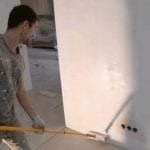How long does it take to wait until it dries primer before wallpapering? This question is often asked by amateur craftsmen who undertook to make repairs on their own. In this case, there is no single answer to how long the primer dries, because different compositions polymerize differently.
For example, there are quick-drying primers. And the wallpaper can begin to be glued in just a few hours. In other cases, you need to wait 10-12 hours, or even the whole day before you start wallpapering.
Priming the walls before wallpapering is necessary for this:
- Initial wall impregnation is required to strengthen the structure of the base materials. A deeply penetrating solution is used here. After polymerization, a strong protective film is formed that protects the walls from moisture and fungus.
- The primer used immediately before gluing the wallpaper is needed to ensure that these same wallpapers are better and longer held on the wall.
- Almost all primers increase the adhesion (adhesive ability) of the base materials and subsequent coatings. In our case, we are talking about putty and wallpaper glue.
- It is proved: when gluing wallpaper on primed walls, less installation materials are consumed.
- Priming of putty walls is required. Putty materials are too susceptible to moisture, and here the impregnation has an important protective function: it prevents the penetration of liquid from the solution of wallpaper glue into the putty wall. As a result, your repair is not threatened with swelling and delamination of the putty.
What determines the drying time
How long do you have to wait before gluing the wallpaper? It all depends on the composition of the primer and the conditions under which the coating dries. As mentioned, quick-drying ones are called so because they are able to dry quickly under normal conditions.
And what does it mean - normal conditions? When impregnation is applied to the surface of the walls, a special atmosphere should be created in the room. For example, at high temperatures, the coating dries much faster than at low temperatures. Heat contributes to the rapid evaporation of liquid substances. Optimum performance is 15-25 degrees with a plus sign.
The second influence factor is air humidity. In a humid environment, any solution will dry longer. The optimal humidity conditions are 65-70%, for some solutions the permissible maximum is 80%.
Drafts are not desirable for the polymerization period. The presence of this influence factor can lead to uneven polymerization. But if a primer for walls “with a smell” is used, after drying the coating it is advisable to ventilate the room (for a comfortable and safe stay). Even airing will help to adjust the temperature conditions of the environment and humidity.
The surface of the walls can also affect the drying time of the mortar. If the base is too dry and has a porous structure, then the substance can simply be absorbed and polymerization will occur too quickly.Therefore, you will need to quickly repeat the treatment, otherwise problems may arise with the drying of a new layer. After all, after polymerization, a hydrophobic protective film appears, which prevents the absorption of liquid.
The thickness of the primer layer may also affect the duration of the polymerization. The thinner the protective coating layer, the shorter the polymerization process. Here you also need to consider the number of layers applied - the more, the longer.
So how much, how long to wait before you can glue the wallpaper? The answer was prompted by the manufacturers themselves. On the product packaging, the optimum polymerization time must be indicated. Observing this requirement, after you can safely proceed to gluing the walls. It depends on the ability of the substances that make up the primer.
Drying time of various composition of primers
- The most common form, equated to the universal, is acrylic mixes. How much to wait for drying? Under normal conditions, you need to wait 4-8 hours, and you can proceed to the installation of wallpaper.
- Oil and contact (with the addition of silica dust) primers will require much more exposure. Only after a day you can proceed to further wall decoration.
- If “quick-drying” is indicated on the package, it is advisable to apply the wallpaper 6 hours after surface treatment.
- Soils based on alkyd resins will dry out for a maximum of 10-12 hours.
- Without taking into account the quality of the base, primer mixtures are conventionally divided into mixtures with a normal drying rate and long-drying ones. It is recommended to proceed to the installation of wallpaper when using the first group of mixtures after a break of 4-6 hours. And the reference interval for long-drying mixtures begins only after 12 hours from the moment of priming.
- Primed plaster will be ready for further work in 2-3 hours. And on putty primed surfaces the wallpaper is applied only after 6-12 hours.
Now it’s clear how much you need to wait to paste the wallpaper in the room. In this case, experts advise priming surfaces in several layers, and with each repeated application, a break in the work is required equal to the period of complete drying of the solution.
Here is such a “simple” arithmetic for preparing surfaces for decorative finishing with wallpaper materials.






